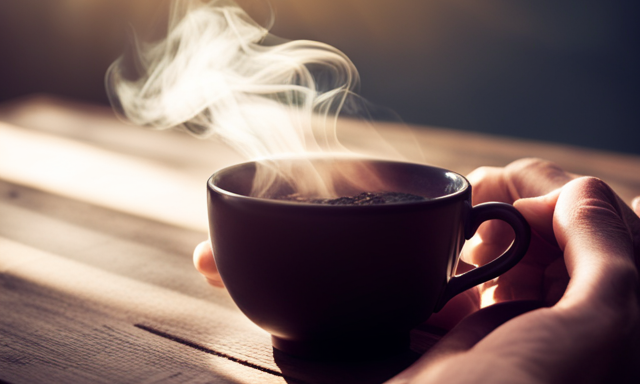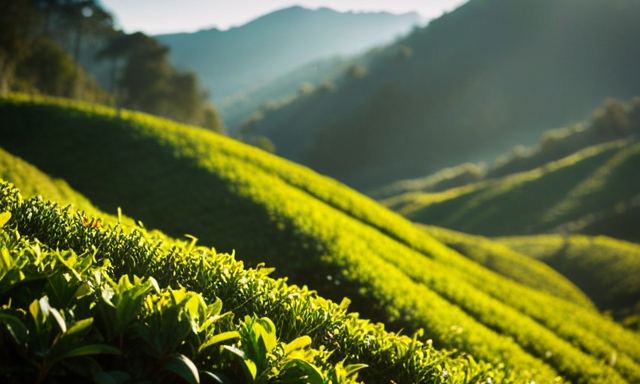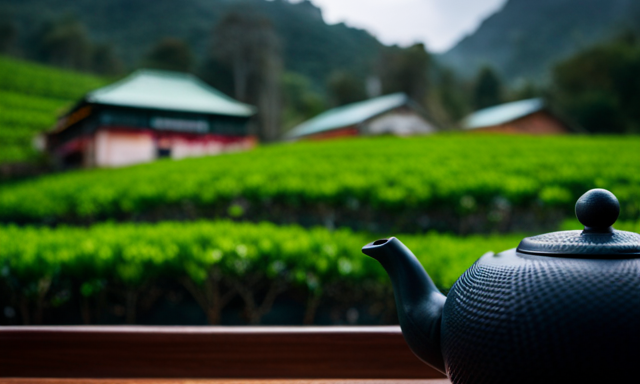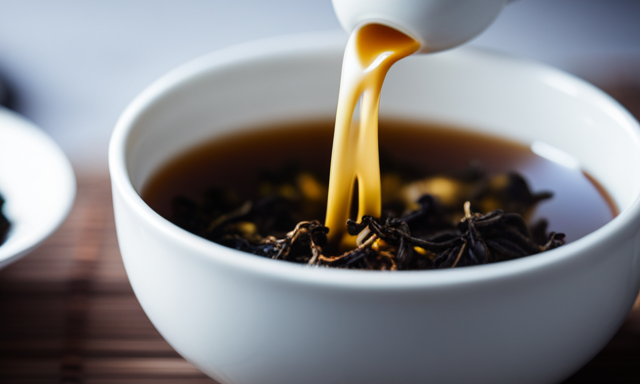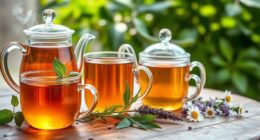Like a warm hug on a chilly day, oolong tea has always been my go-to remedy when I’m feeling under the weather. Whether it’s a stuffy nose, a scratchy throat, or just a general sense of malaise, oolong tea never fails to provide comfort and relief.
In this article, I will explore the incredible health benefits of oolong tea and how it can help alleviate common ailments. From its healing properties to its role in weight management and mental clarity, oolong tea has proven time and time again to be a natural powerhouse.
I will also share tips on how to prepare oolong tea for maximum benefits and how to incorporate it into your daily routine. So, if you’re looking for a natural and soothing remedy to combat illness, join me as we delve into the world of oolong tea and harness its healing powers.
Key Takeaways
- Oolong tea can help relieve respiratory discomfort and congestion
- Oolong tea promotes relaxation and restorative rest
- Oolong tea can support weight management goals by suppressing appetite and boosting metabolism
- Oolong tea serves as a natural remedy for improving digestion and overall well-being
The Health Benefits of Oolong Tea
Drinking oolong tea can provide you with numerous health benefits, such as boosting your metabolism and improving your heart health. Oolong tea is known for its healing properties, which can help with weight management. Research shows that oolong tea can increase metabolism and fat oxidation, making it an excellent choice for those looking to shed a few pounds.
Additionally, oolong tea contains antioxidants that can reduce the risk of heart disease by improving blood flow and reducing inflammation. These healing properties of oolong tea make it a great addition to a healthy lifestyle.
In the next section, we’ll explore how oolong tea can further enhance your well-being and support your immune system.
The Healing Properties of Oolong Tea
Indulging in a warm embrace of this aromatic elixir is like inviting a soothing balm for your weary body. Oolong tea is renowned for its healing benefits, making it a go-to remedy when feeling under the weather. Here are the key reasons why oolong tea can help in times of illness:
-
Boosts the immune system: Oolong tea is rich in antioxidants, which can strengthen the body’s natural defense system against viruses and infections.
-
Relieves congestion: The warm steam from a freshly brewed cup of oolong tea can help clear nasal passages and ease respiratory discomfort.
-
Soothes the throat: The natural compounds in oolong tea have a soothing effect on a sore throat, providing relief and reducing inflammation.
-
Promotes relaxation: The combination of aroma and warmth in oolong tea can help calm the mind and relax the body, aiding in restorative rest.
To maximize the healing benefits, it’s essential to prepare oolong tea in the traditional way. Now, let’s explore how to prepare oolong tea for maximum benefits without missing a beat.
How to Prepare Oolong Tea for Maximum Benefits
To truly unlock the potent healing properties of this aromatic elixir, immerse yourself in the art of preparing oolong tea for maximum benefits. When it comes to preparing oolong tea, the key is to strike a balance between time, temperature, and flavor. To ensure maximum flavor, steep the leaves for 3-5 minutes in water that is around 180-190°F. This allows the tea to release its full range of flavors, from the delicate floral notes to the rich, earthy undertones. For an extra boost of antioxidants, use fresh, filtered water. As for the best time to drink oolong tea, many experts recommend sipping it in the morning or afternoon to take advantage of its energizing properties. Now that you know how to prepare oolong tea for maximum flavor, let’s explore its role as a natural remedy for common ailments.
Oolong Tea as a Natural Remedy for Common Ailments
Try incorporating this soothing beverage into your daily routine. Can sipping on a warm cup of this aromatic elixir be the natural remedy you’ve been searching for to alleviate common ailments? Here are four ways oolong tea can help improve your health:
-
Oolong tea for respiratory health: The antioxidants and anti-inflammatory properties in oolong tea may help reduce respiratory symptoms, such as coughing and wheezing.
-
Oolong tea for digestion improvement: Oolong tea has been shown to promote healthy digestion by increasing the production of digestive enzymes and reducing inflammation in the gut.
-
Oolong tea for weight management: Studies suggest that oolong tea can help boost metabolism and increase fat oxidation, making it a potential aid in weight management.
-
Oolong tea for overall well-being: The combination of antioxidants, polyphenols, and other beneficial compounds in oolong tea may have a positive impact on overall health and well-being.
As you explore the benefits of oolong tea for common ailments, let’s delve into its role in weight management.
Oolong Tea and Weight Management
When it comes to weight management, oolong tea can be a helpful tool in achieving your goals. One of the ways it can assist is by boosting metabolism, allowing your body to burn calories more efficiently.
Additionally, oolong tea has been shown to suppress appetite, helping you feel fuller for longer and reducing the likelihood of overeating.
Lastly, it supports healthy weight loss by providing a natural source of hydration and promoting a balanced lifestyle.
Boosting Metabolism
Did you know that drinking oolong tea can give your metabolism a much-needed boost? Oolong tea contains compounds that’ve been shown to increase energy levels and promote fat burning in the body.
When consumed regularly, oolong tea can help rev up your metabolism, allowing you to burn more calories throughout the day.
To maximize the metabolism-boosting effects of oolong tea, here are some tips to keep in mind:
- Stay hydrated: Drinking enough water alongside oolong tea can enhance its effectiveness.
- Pair it with exercise: Combining oolong tea with regular physical activity can further enhance your metabolism.
- Avoid sweeteners: Adding sugar or artificial sweeteners to your oolong tea can negate its potential benefits.
- Enjoy it hot: Drinking oolong tea hot can stimulate your metabolism even more.
- Be consistent: To see noticeable results, make oolong tea a part of your daily routine.
Drinking oolong tea not only helps with boosting metabolism but also plays a role in suppressing appetite, which we’ll explore in the next section.
Suppressing Appetite
Suppressing appetite is essential for weight management and can be achieved through various methods, such as increasing fiber intake, which has been shown to reduce calorie consumption by up to 20%. When it comes to controlling cravings and managing appetite, oolong tea can be a helpful tool. This tea contains polyphenols that have been found to suppress appetite and increase feelings of fullness. Additionally, oolong tea can help regulate blood sugar levels, which can further support appetite control.
To better understand the impact of oolong tea on appetite, let’s take a look at the following table:
| Oolong Tea Benefits for Appetite Control |
|---|
| Reduces cravings |
| Increases feelings of fullness |
| Regulates blood sugar levels |
By incorporating oolong tea into your routine, you can support your weight management goals by suppressing cravings and controlling your appetite. This sets the foundation for the subsequent section on supporting healthy weight loss.
Supporting Healthy Weight Loss
To achieve healthy weight loss, it’s important to focus on supporting your body through proper nutrition and regular exercise. Here are some weight loss tips and healthy diet plans to help you reach your goals:
-
Incorporate more fruits and vegetables into your meals. They’re low in calories and high in nutrients, keeping you full and satisfied.
-
Choose lean sources of protein. Opt for chicken, turkey, fish, tofu, or legumes to provide your body with essential amino acids.
-
Stay hydrated. Drinking enough water helps control hunger and boosts metabolism.
-
Limit processed foods and added sugars. These can contribute to weight gain and hinder your progress.
By following these tips and maintaining a healthy lifestyle, you can support your body in achieving your weight loss goals.
Transitioning into the next section about oolong tea and heart health, let’s explore its benefits.
Oolong Tea and Heart Health
When it comes to heart health, oolong tea has some impressive benefits. First and foremost, it’s been shown to help lower cholesterol levels, which is crucial for maintaining a healthy cardiovascular system.
Additionally, regular consumption of oolong tea has been associated with a reduced risk of heart disease, making it a great addition to a heart-healthy lifestyle.
Lastly, oolong tea has been found to improve cardiovascular function, promoting better blood flow and overall heart health.
So, if you’re looking for a natural way to support your heart, oolong tea is definitely worth considering.
Lowering Cholesterol Levels
Sipping on a warm cup of oolong tea is like having a gentle breeze sweep away cholesterol, leaving you feeling refreshed and healthy.
Oolong tea has been shown to help lower cholesterol levels by reducing triglyceride levels and preventing plaque buildup in the arteries.
Studies have found that the polyphenols found in oolong tea can inhibit the absorption of cholesterol and promote its excretion from the body. This can lead to a decrease in LDL cholesterol, which is often referred to as the ‘bad’ cholesterol.
By incorporating oolong tea into your daily routine, you can take a proactive step towards reducing the risk of heart disease. So, why not make oolong tea a part of your healthy lifestyle and enjoy the benefits it offers?
Reducing the Risk of Heart Disease
When it comes to improving cardiovascular health, oolong tea is a powerful ally. Not only does it help lower cholesterol levels, but it also reduces the risk of heart disease. How does it do this? Well, oolong tea contains antioxidants that can help reduce inflammation in the body.
Inflammation is a key factor in the development of heart disease, so by drinking oolong tea, you’re taking steps to protect your heart. Additionally, oolong tea has been found to prevent blood clots, which can lead to heart attacks and strokes. By promoting healthy blood flow and preventing clot formation, oolong tea helps keep your heart healthy and strong.
Now, let’s delve into how oolong tea can improve cardiovascular function and overall well-being.
Improving Cardiovascular Function
Boost your cardiovascular function and enhance overall well-being by incorporating oolong tea into your daily routine. Oolong tea has been found to have numerous benefits for improving blood circulation and managing hypertension. The antioxidants present in oolong tea help to relax blood vessels, allowing for better blood flow throughout the body. This improved circulation can reduce the risk of cardiovascular diseases such as heart attacks and strokes. Additionally, oolong tea has been shown to lower blood pressure, making it a great choice for those with hypertension.
By regularly consuming oolong tea, you can support your cardiovascular health and promote a healthier heart.
Transitioning into the next section about oolong tea for mental clarity and focus, it’s important to note that oolong tea offers not only physical benefits but also mental well-being.
Oolong Tea for Mental Clarity and Focus
When it comes to boosting cognitive function and improving mental clarity, I find that incorporating oolong tea into my daily routine has been incredibly beneficial.
Not only does it provide a natural energy boost without the jitters commonly associated with coffee, but it also helps improve my concentration and memory.
I’ve noticed that since I started drinking oolong tea regularly, I’ve been able to stay focused for longer periods of time and retain information more effectively.
Enhancing Cognitive Function
Drinking a cup of oolong tea is like giving your brain a turbo charge, improving your cognitive function to superhero levels. When you need a boost in productivity or want to enhance your brain function, oolong tea can be a game-changer.
Here’s how it works:
- Oolong tea contains caffeine and L-theanine, which work together to improve alertness and focus.
- The antioxidants in oolong tea protect brain cells from damage and reduce the risk of cognitive decline.
- Oolong tea has been shown to enhance memory and learning abilities, making it a great choice for students or those needing to absorb information quickly.
By enhancing cognitive function, oolong tea can help you stay sharp and perform at your best. And the best part? It does all this while providing a natural energy boost, without the jitters or crashes associated with other caffeinated beverages.
Providing a Natural Energy Boost
Get ready to experience a natural energy boost like never before, as oolong tea ignites your senses and propels you through the day with renewed vitality. When you’re feeling drained or sluggish, oolong tea can provide the perfect natural remedy to improve productivity and keep you focused. This delightful brew contains caffeine and theanine, a unique combination that enhances alertness and mental performance. Unlike other caffeinated beverages, oolong tea provides a gentle and sustained energy lift without the jitters or crash. It keeps you energized throughout the day, without interfering with your sleep at night. Take a look at the table below to see some of the key benefits of oolong tea as a natural energy booster:
| Benefits of Oolong Tea |
|---|
| Sustained energy |
| Increased alertness |
| Improved focus and concentration |
| Enhanced productivity |
By incorporating oolong tea into your routine, you can improve your energy levels and overall cognitive function. Now, let’s delve into how oolong tea can also help improve concentration and memory.
Improving Concentration and Memory
After discussing how oolong tea provides a natural energy boost, let’s now explore how it can also enhance concentration and memory.
As someone who often struggles with staying focused and retaining information, I’ve found oolong tea to be a game-changer. Its unique combination of caffeine and L-theanine promotes alertness and relaxation simultaneously, leading to improved cognitive function.
Studies have shown that the antioxidants in oolong tea help protect brain cells from damage and may even stimulate the growth of new neurons. By incorporating oolong tea into my daily routine, I’ve noticed a significant improvement in my productivity and ability to learn new things.
Now, let’s delve into how oolong tea can aid in detoxification and cleanse our bodies from within.
Oolong Tea and Detoxification
When it comes to detoxification, oolong tea has some powerful benefits. First, it supports liver health by aiding in the breakdown and elimination of toxins.
Second, it helps flush out toxins from the body, promoting a healthier and more balanced internal environment.
And finally, oolong tea cleanses the digestive system, helping to improve digestion and prevent the buildup of waste.
So if you’re looking for a natural way to support your body’s detoxification process, oolong tea is definitely worth considering.
Supporting Liver Health
Boost your liver health with oolong tea and experience a rejuvenated and vibrant organ. Oolong tea has been shown to support liver detoxification and promote liver regeneration. Here’s how oolong tea can benefit your liver:
-
Antioxidant power: Oolong tea is rich in antioxidants that help protect the liver from oxidative stress and damage caused by toxins.
-
Liver enzyme support: Research suggests that oolong tea can help maintain healthy levels of liver enzymes, which’re essential for detoxification.
-
Fat metabolism: Oolong tea may aid in the breakdown of fats and prevent the accumulation of fatty deposits in the liver.
By incorporating oolong tea into your daily routine, you can support your liver’s natural detoxification processes and promote overall liver health. This’s crucial for flushing out toxins from the body and maintaining optimal well-being.
Flushing out Toxins from the Body
To achieve optimal well-being, it’s time to let your body’s natural river of health flow, flushing out toxins and restoring balance.
One of the best ways to support this natural detoxification process is by incorporating oolong tea into your daily routine. Oolong tea contains powerful antioxidants that help to eliminate harmful toxins from your body. These antioxidants work by neutralizing free radicals and reducing oxidative stress, which can lead to a variety of health issues.
By regularly consuming oolong tea, you can support your liver’s ability to metabolize toxins and promote overall liver health. Additionally, oolong tea can help to improve digestion and promote healthy bowel movements, further aiding in the elimination of toxins from your body.
So, let’s move on to the next section and explore how oolong tea can cleanse the digestive system.
Cleansing the Digestive System
By incorporating oolong tea into your daily routine, you can support your body’s natural detoxification process and promote a healthier digestive system. Oolong tea is rich in antioxidants that help cleanse the digestive system and eliminate harmful toxins. It acts as a gentle laxative, aiding in regular bowel movements and preventing constipation.
Oolong tea also contains compounds that can help regulate gut bacteria, promoting a healthy balance and reducing the risk of digestive issues such as bloating and gas. Additionally, oolong tea has been shown to improve digestion by increasing the production of digestive enzymes.
Incorporating oolong tea into your cleansing diet can provide numerous benefits for your digestive health. Now, let’s explore how you can easily incorporate oolong tea into your daily routine.
Incorporating Oolong Tea into Your Daily Routine
Imagine starting your day by sipping on a warm cup of fragrant oolong tea, slowly easing into a routine that incorporates this delightful beverage. Not only does oolong tea offer a delicious flavor, but it also provides numerous health benefits when incorporated into your daily routine.
One way to reap the benefits of oolong tea is by incorporating it into your skincare routine. Oolong tea contains antioxidants that can help protect your skin from damage caused by free radicals, promoting a healthy and youthful complexion. Additionally, oolong tea is known for its antibacterial properties, which can help fight against acne and other skin issues.
Furthermore, oolong tea has been shown to have positive effects on gut health. The polyphenols found in oolong tea can help promote the growth of beneficial gut bacteria, aiding in digestion and improving overall gut health.
Incorporating oolong tea into your daily routine can be as simple as enjoying a cup in the morning or before bed. Try adding it to your skincare routine or pairing it with healthy meals for added benefits. Harnessing the healing powers of oolong tea can be a simple and enjoyable addition to your everyday life.
Conclusion: Harnessing the Healing Powers of Oolong Tea
Incorporating oolong tea into your daily routine can be a simple and enjoyable way to harness its healing powers and improve your overall well-being. Did you know that studies have shown that regular consumption of oolong tea can lower the risk of developing heart disease by up to 61%? Not only does oolong tea have the potential to protect your cardiovascular health, but it also offers a range of other benefits for your overall well-being.
Take a look at the table below to see some of the ways oolong tea can positively impact your health:
| Benefit | Description |
|---|---|
| Boosts metabolism | Helps burn calories and aids in weight management |
| Supports digestion | Soothes the digestive system and promotes healthy gut function |
| Enhances brain function | Improves focus, alertness, and mental performance |
| Strengthens immune system | Contains antioxidants that fight against free radicals and boost immune function |
| Promotes relaxation | Reduces stress and anxiety levels, promoting a sense of calm and relaxation |
By incorporating oolong tea into your daily routine, you can reap the many benefits it offers for your overall well-being. So, why not start enjoying a cup of oolong tea today and harness its healing properties for a healthier you?
Frequently Asked Questions
Can oolong tea help with the common cold or flu?
Yes, oolong tea can help with respiratory infections. It has been shown to boost the immune system during illness, providing relief from symptoms and aiding in recovery.
Is oolong tea beneficial for digestive issues?
Oolong tea can be beneficial for digestive issues. It has been shown to aid in weight loss and help control blood sugar levels. Incorporating oolong tea into your routine may provide relief and support for digestive health.
Can oolong tea help with stress and anxiety?
Oolong tea can help alleviate stress and anxiety. Research suggests that the antioxidants in oolong tea promote relaxation and reduce cortisol levels. Additionally, it may aid in better sleep and weight loss.
Does oolong tea have any antioxidant properties?
Yes, oolong tea has antioxidant benefits. Studies show that it contains polyphenols, which can help fight oxidative stress and reduce the risk of chronic diseases. Additionally, oolong tea has been linked to weight loss.
Can oolong tea improve skin health and complexion?
Oolong tea can improve skin health and complexion by increasing skin elasticity and reducing acne. Studies have shown that the antioxidants and polyphenols in oolong tea have a positive impact on skin, promoting a healthier and clearer complexion.
Conclusion
In conclusion, I must say that Oolong tea is truly a miraculous elixir. It’s a must-have in your daily routine because of its multitude of health benefits. It boosts the immune system, aids in weight management, and has been trusted for centuries for its healing properties. So why not give it a try? Incorporate this wondrous tea into your life and experience its transformative powers. It’s like a magical potion that can turn your health around in a sip, leaving you feeling rejuvenated and revitalized.

